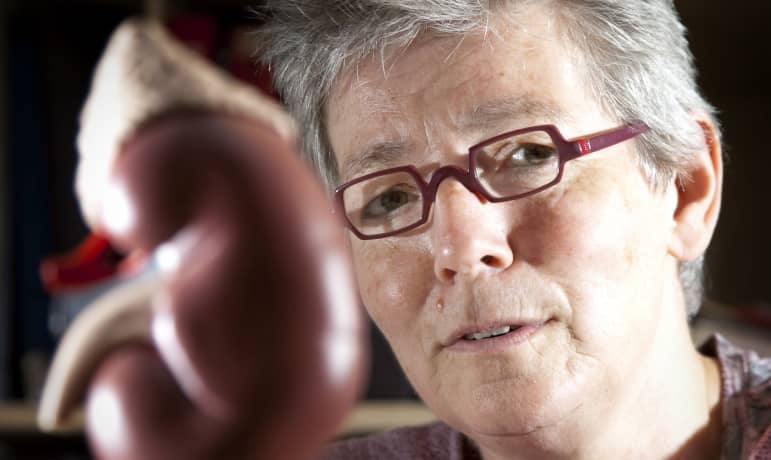The motivation for a healthy lifestyle is usually very high among people who have had a kidney transplant. But they do need help in doing so, says Prof. Dr. Gerjan Navis upon her retirement. The nephrologists have overlooked this vital part of their job for far too long, while the opportunities are there for the taking.
Patients undergoing a kidney transplant are particularly motivated to remain as healthy as possible afterwards. “It makes sense, because they have their lives back after the long and often grueling process of kidney dialysis,” says Navis. “A kidney disease causes enormous suffering. They often ask the question what they can do themselves to stay healthy. I have always explained to them that they can make a difference with a healthy lifestyle, that they can only do this themselves, but that we will help them as best as possible.”
The persistent idea that lack of motivation stands in the way of lifestyle change does not hold true for most transplant patients, says Navis. “If things don’t go well, it’s all too easy to blame for lack of motivation. As nephrologists, we have a lot of overdue work to do.”
Gain weight and eat less
People gain weight quickly after a kidney transplant. Navis: “The prednisolone they take causes weight gain and also stimulates the appetite. They therefore gain an average of five kilos in the first year, with peaks of fifteen kilos. I once met a patient in a transplant group whom I simply no longer recognized for that reason. So we as nephrologists think: they eat too much. I also learned this in my training. But of course you can just measure what these people actually eat. And what happened when we started doing this? That we were completely wrong. They eat less, and therefore get less of all nutrients. For salt, potassium and protein, we had actually had those figures available for twenty years, but we thought we knew it so well that we never looked at them systematically.”
After transplantation, people therefore not only eat less salt, but also less potassium. “They eat even less vegetables than the average Dutch person,” says Navis, “less protein too. A third have a protein intake of less than one gram per kilogram of body weight. Some are even below 0.8 grams, which is an independent determinant of mortality and poor quality of life. You are then extremely tired and can therefore no longer move, making you fatter. A vicious vicious circle. And important to report: a high protein intake improves not only quality of life and survival, but also the survival of the kidney.”
After transplantation, people therefore not only eat less salt, but also less potassium. “They eat even less vegetables than the average Dutch person,” says Navis, “less protein too. A third have a protein intake of less than one gram per kilogram of body weight. Some are even below 0.8 grams, which is an independent determinant of mortality and poor quality of life. You are then extremely tired and can therefore no longer move, making you fatter. A vicious vicious circle. And important to report: a high protein intake improves not only quality of life and survival, but also the survival of the kidney.”
It doesn’t happen by itself
The point is that these people had to follow a protein-restricted diet during the time when they were kidney patients. The same problem occurs in the area of potassium intake. “We’ve always taught these people in their dialysis time that potassium is dangerous for them,” says Navis. “That sticks. But after the transplant, too low a potassium intake is an independent determinant for death. So it is important that they eat enough vegetables. We are only now realizing that after transplantation, when the dialysis diet has expired, people will not automatically start eating healthy again, and that the fear of potassium will remain in them for a long time. So you have to better guide people in making the switch from a (pre)dialysis diet to a healthy diet, and take into account their history, not only medically but also in terms of diet.”
What does not help, says Navis, is that the guidelines have not yet addressed this. “That in itself is right,” she says. “After all, amendments to a guideline must be well scientifically substantiated, and for a long time no good data were available on the relationship between nutrition and outcomes after transplantation. But the current data shows that this needs to be addressed quickly in the guidelines.”
The guidelines should also pay more attention to the relationship between kidney transplantation and age, she says. “These are mostly older patients. Half of the healthy elderly population already has a sub-optimal vitamin intake or even a deficiency. In our patient population, this is an extra large problem that may very well explain some of their vulnerability. The guidelines are also lagging behind in this area.”
food skills
At the same time, Navis argues that nephrologists should not wait for the guidelines to be amended, because much improvement is already possible within the current guidelines. “Supporting patients in a targeted way is already possible now,” she says. “The data about their eating pattern is an important starting point. When asked, our patients appear to have a particular need for practical advice: better food skills, in other words. This practical approach has been neglected far too much in the lifestyle world, probably because theoretical knowledge is overvalued in our society. As part of the Lifelines study1 we investigated the extent to which people eat according to the Health Council’s Healthy Diet guideline. It turns out that almost no population group does that, but older women do to a large extent. They have learned health skills at domestic science school. We need to bridge that gap between theory and practical skills again.”
Is there a role for the nephrologist in this? “Yes,” says Navis emphatically. “Not in an executive sense, of course. The nephrologists are not the party that will lead a cooking workshop. But we need to pay much more attention to the importance of teaching kidney patients health skills and we need to come to structural cooperation with paramedics for this. We have to organize it. It should not depend on an individual dietician whether the patient is provided with these skills. It must be an integral part of the guidance that the patient receives during the kidney transplant. In that respect it is great that the profession of lifestyle coach is developing so much. This can be valuable in this regard, provided that it has a care background. A nurse who has followed the relevant modules for this can also take on this role. But whichever professional does well, we should in any case work together much more.”
Gerjan Navis worked as an internist-nephrologist at UMC Groningen until her retirement last May. In 2000 she became professor of experimental nephrology and in 2015 the chair of nutrition in medicine was added. In her research she has always focused on the great preventive importance of lifestyle management to prevent the deterioration of kidney function and complications of kidney damage. She is the initiator of the Lifestyle Medicine concept, lifestyle as medicine, and the founder of lifestyle medicine at the UMCG. On the occasion of her retirement, she was appointed Knight in the Order of the Netherlands Lion.
Bron:
–


